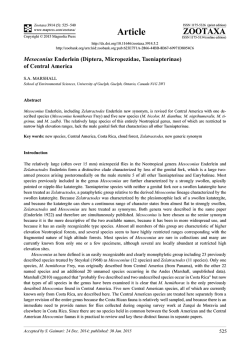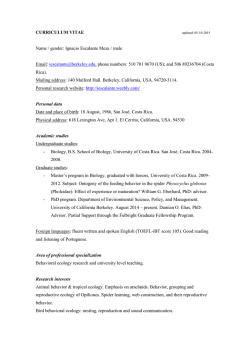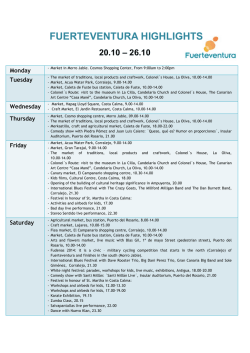
A new species of Calyptranthes (Myrtaceae)
Zamora, N.A., S-Y. Kim, S. Choi, and R. Espinoza O. 2016. A new species of Calyptranthes (Myrtaceae) from Costa Rica. Phytoneuron 2016-65: 1–5. Published 29 September 2016. ISSN 2153 733X A NEW SPECIES OF CALYPTRANTHES (MYRTACEAE) FROM COSTA RICA NELSON A. ZAMORA Investigador Asociado, Herbario Nacional de Costa Rica Departamento de Historia Natural, Museo Nacional de Costa Rica Apdo. 749-1000, San José, Costa Rica [email protected] SOO-YONG KIM Senior Researcher, International Biological Material Research Center Korea Research Institute of Bioscience and Biotechnology Apdo. 34141 Daejeon, South Korea [email protected] SANGHO CHOI Director and Senior Researcher, International Biological Material Research Center Korea Research Institute of Bioscience and Biotechnology Apdo. 34141, Daejeon, South Korea [email protected] and ROBERTO ESPINOZA O. Botánico residente, Área de Conservación Guanacaste Apdo. 169-5000, Liberia, Guanacaste, Costa Rica [email protected] ABSTRACT Previous collections of Calyptranthes guanacastensis have been misidentified as C. chytraculia (L.) Sw., which is the most closely similar species, but the two differ greatly in habitat type and morphological characters (see below). While carrying out field work and research activities by INBioKRIBB-2015´s project in the Área de Conservación Guanacaste (ACG), we were able to collect abundant flowering material of this species. After studying its habitat and collections (including previous collections), we conclude that represents a distinct and previously undescribed species. RESUMEN Colecciones previas de Calyptranthes guanacastensis, habían sido mal identificadas bajo la especie C. chytraculia (L.) Sw., la cual es la especie más relacionada, sin embargo, ellas difieren significativamente en el tipo de hábitat y otros caracteres morfológicos (ver adelante). Mientras realizábamos trabajo de campo y actividades de investigación por el proyecto INBio-KRIBB-2015 en el Área de Conservación Guanacaste (ACG), logramos recolectar suficiente y buen material con flores de esta especie. Posterior a un estudio, de las características de su hábitat y el material recolectado (incluido unas pocas colecciones previas), concluimos que representa una especie nueva distinta y sin describir. Calyptranthes is a tropical American genus of Myrtaceae that is distributed from the southeast USA (South Florida) down to northern Argentina, the Antilles, and the Bahamas. The genus comprises about 100 species; 6 of them occur in Costa Rica (Holst & Kawasaki 2007). It is distinguished from other Myrtaceae genera by its conspicuously calyptriform, circumscissile, and deciduous calyx that falls as a unit or stays attached to the hypanthium on a single point (Holst & Kawasaki 2007). Also, Calyptranthes are mainly shrubs or trees, vegetatively characterized by persistent dichotomously branching twigs. We describe Calyptranthes guanacastensis as a new species, illustrate it, and compare it with closely related species. Zamora et al.: New species of Calyptranthes from Costa Rica 2 CALYPTRANTHES GUANACASTENSIS N. Zamora, S. Kim, & R. Espinoza, sp. nov. TYPE: COSTA RICA. Guanacaste. Cantón La Cruz, Área de Conservación Guanacaste, Sector El Hacha, Estación Los Almendros, sendero al cerro El Hacha, rumbo a la Quebrada El Tigre, 11º 01’ 43.2’’ N, 85º 31’ 31.6’’ W, 300 m, 18 Mar 2015 (fl), Zamora et al. 7559 (holotype: CR; isotype: KRIB). Figures 1-2. Confused with Calyptranthes chytraculia by its reddish or ferrugineous-pilose inflorescences but differing markedly by its much smaller leaves [(1.4–) 3–10(–12.1) x (1.5–) 2–5.3 cm] with obscure or weakly evident secondary veins (in vivo), the inflorescences less or sparsely yellowish or ferrugineouspilose pubescence with angulate main axes and laxiflorous branches. Moreover, it differs greatly in its habitat type, which is strongly dry to humid seasonal, semidecidous to evergreen, gallery or riparian forest. Shrub or small tree of 4–5 m tall; old twigs essentially glabrous, young parts with dense, very short, appressed, ferrugineous-sericeous pubescence. Leaves: petiole 5–10 mm long, caniculate, appressed ferrugineous-sericeous beneath; lamina (1.4–)3–10(–12.1) x (1.5–)2–5.3 cm, elliptic, apex obtuse, acute to short-acuminate, sometimes apiculate, base obtuse, both surfaces glabrous when mature, only sparsely ferrugineous-sericeous beneath along the costa near the base, lateral veins 10– 16 per side, weakly impressed and flat above, brochidodromous and weakly elevated underneath, reticulation obscure on both sides. Inflorescence axillary panicles, in pairs or 3–4 per axil, 5.7–8.7 cm long, peduncle 2.5–4.3 cm long, axes angulate to quadrangular, densely appressed ferrugineoussericeous to densely pilose; bracts 0.5 mm long, deciduous. Flowers white, sessile, hypanthium 2 mm long, pyriform to cupuliform, densely ferrugineous-pilose; calyx calyptriform, circumscissile, calyptra 1.5 x 1.5 mm, laterally attached, concave, deciduous; flower buds obovoid, apiculate; petals 0; stamens many, white; pistil ca 5 mm long, glabrous. Fruits rounded to globose or ovoid, 7 mm long, 7 mm wide, glabrous, surface minutely papillose, apex shallowly urceolate, dark purple when ripe; pedicel 1–2 mm long. Seeds not seen. Flowering material has been collected from January to March; fruiting in June and August. Studying collections at the National Herbarium of Costa Rica, we found that some previous collections (see exsiccatae below) of Calyptranthes guanacastensis were misidentified as C. chytraculia (L.) Sw. But they can easily be distinguished because the leaves of C. guanacastensis are much smaller with obscure or weakly evident secondary veins (in vivo) (Fig. 2, C-D), the inflorescences are less or sparse yellowish or ferrugineous-pilose pubescence with angulate main axes and laxiflorous branches (Fig. 2, A-B). In contrast, in C. chytraculia the leaves are normally much bigger (10–17 x 4–7 cm) with strongly prominent venation (below), inflorescence tend to be larger (7–14 cm) with cylindrical, densely dark-ferrugineous or dark reddish-pilose axes and with densiflorous or multiflorous branches. Both species also differ greatly in habit types. Calyptranthes guanacastensis, so far as known, is restricted to the northwestern part of the Cordillera of Guanacaste, growing at the lowermiddle (300-700 m) Pacific slope, in strongly dry to humid seasonal, semideciduous to evergreen, gallery or riparian forest patches (Fig. 3). Calyptranthes chytraculia occurs mainly at the lowlandmiddle (0-850 m) Caribbean slope (except, for a population in the Osa Peninsula, Southern Pacific slope). It is distributed in wet or rain forest habitats, sometimes along coastal flat swampy forests. Zamora et al.: New species of Calyptranthes from Costa Rica 3 Figure 1. Calyptranthes guanacastensis. A. Twig with inflorescences. B. Submarginal vein and pubescence of lower surface. C. Petiole, channelled above. D. Dichotomously branching twig. E. Buds, showing apiculum and pubescence. Drawing by Claudia Aragón. Zamora et al.: New species of Calyptranthes from Costa Rica A B C D 4 Figure 2. Calyptranthes guanacastensis. A. Terminal inflorescence showing the flowers. B. Inflorescences showing grouping at the twig´s apex. C. Leaves - upper surface. D. Leaves -lower surface. All from Zamora et al. 7559. Figure 3. Landscape view of Calyptranthes guanacastensis habitat: dry semideciduous to evergreen seasonal forests patches along a watershed. Photograph by N. Zamora. Zamora et al.: New species of Calyptranthes from Costa Rica 5 Additional material examined. COSTA RICA. Guanacaste: Liberia. Área de Conservación Guanacaste, Estación Cacao, Sendero Casa Frank, 10º 57’ 20’’ N, 85º 29’ 21’’ W, 620 m, 12 Ago 2014 (fr), Zamora et al. 7105 (CR, KRIB). Liberia. Parque Nacional Guanacaste, cuenca del Río Tempisque, Estación Maritza, Sendero a Cacao, 10º 57 06 N, 85º 28’ 09’’ W, 600 m, 12 Jun 1996 (fr). La Cruz. Parque Nacional Guanacaste, cuenca del Río Sapoa, Sector Los Almendros (El Hacha), sendero la Bejuquilla, 11º 02’ 00’’ N, 85º 31’ 40’’ W, 300 m, 21 Ene 1998 (fl), Espinoza et al. 1759 (CR). Liberia. Parque Nacional Rincón de la Vieja, cuenca del Río Tempisque, sector Los Almendros, 10º 45’ 30’’ N, 85º 19’ 04’’, 700 m, 2 Feb 1997 (fl), Espinoza 1664 (CR). Liberia, Parque Nacional Guanacaste, cuenca del Río Tempisque, Volcán Orosi, Estación Biológica Maritza, 10º 57’ 19’’ W, 85º 29’ 29’’ W, 650 m, 12 Mar 2003 (fl), Boyle et al. 7080 (CR). ACKNOWLEDGEMENTS The authors thank Project INBio-KRIBB for supporting field and herbarium work. This research was supported by a grant from "Procurement and development of foreign biological resources" funded by Ministry of Science ICT and Future Planning of Korean government (NRF-2012K1A 1A3307858). We also thank Claudia Aragón for the beautiful line drawings. LITERATURE CITED Holst, B.K. and M.L. Kawasaki. 2007. Calyptranthes. Pp. 731-735, in B.E. Hammel, M.H. Grayum, C. Herrera, and N. Zamora (eds.). Manual de Plantas de Costa Rica, Vol. VI. Dicotiledóneas (Haloragaceae-Phytolacaceae). Monogr. Syst. Bot., Missouri Bot. Gard. 111: 1–933.
© Copyright 2024








